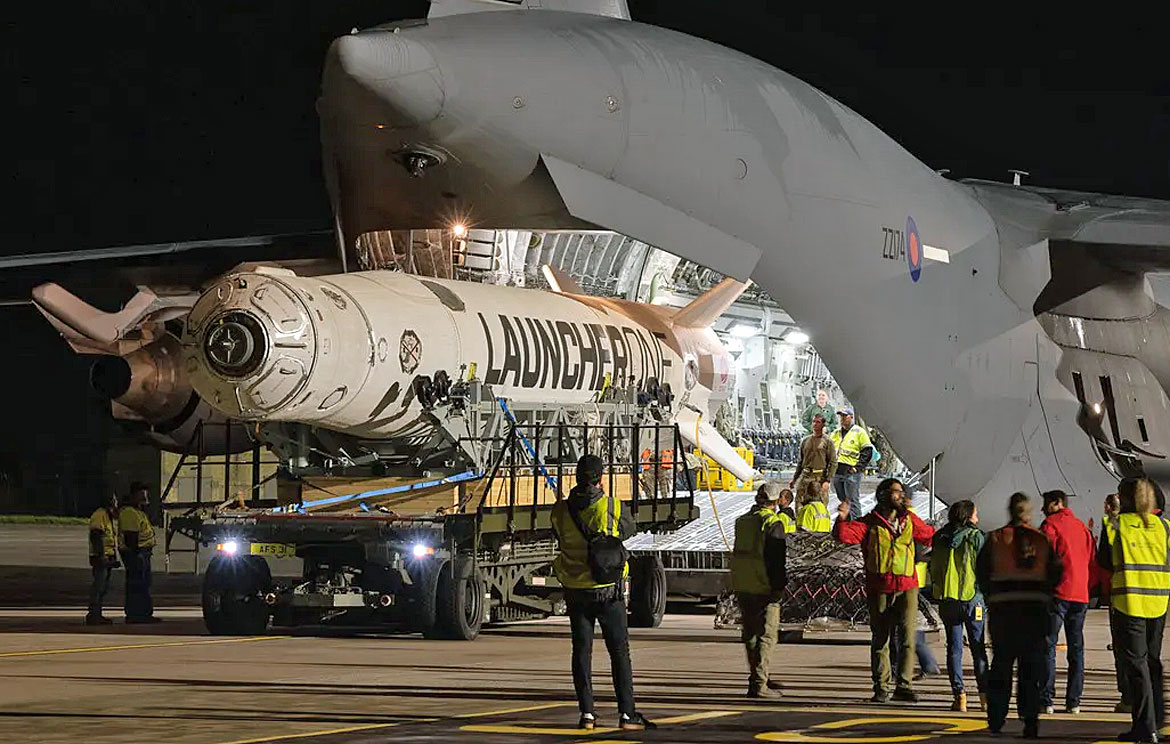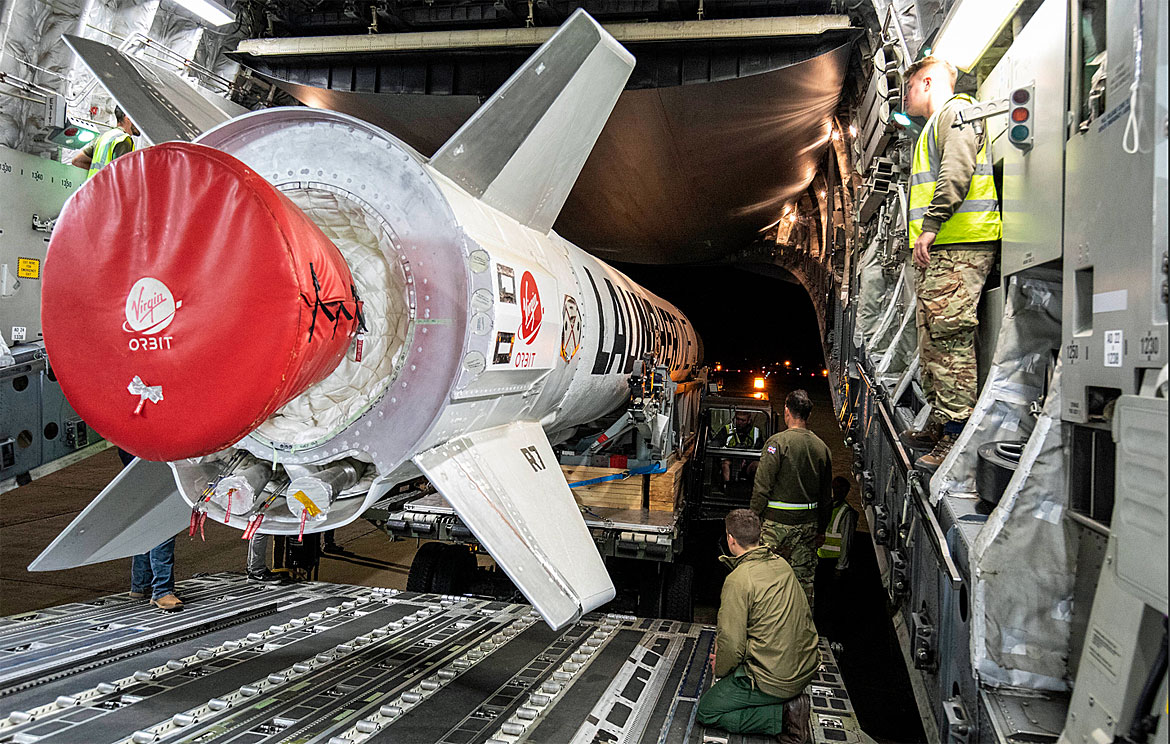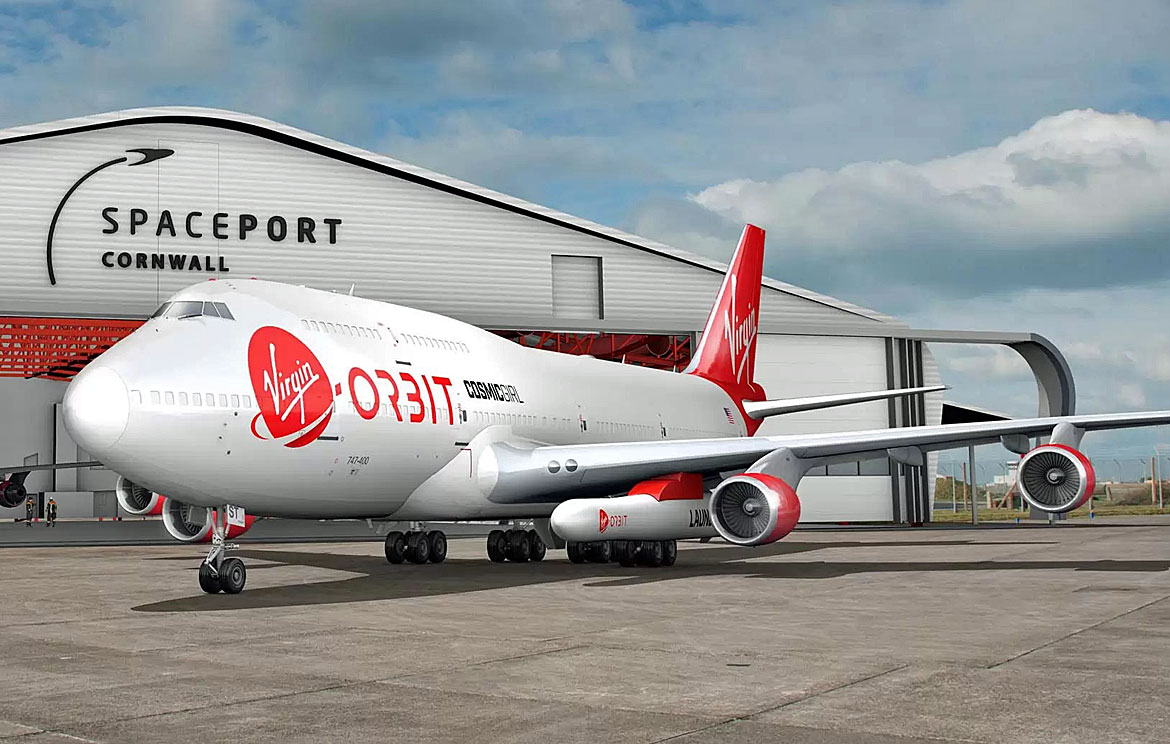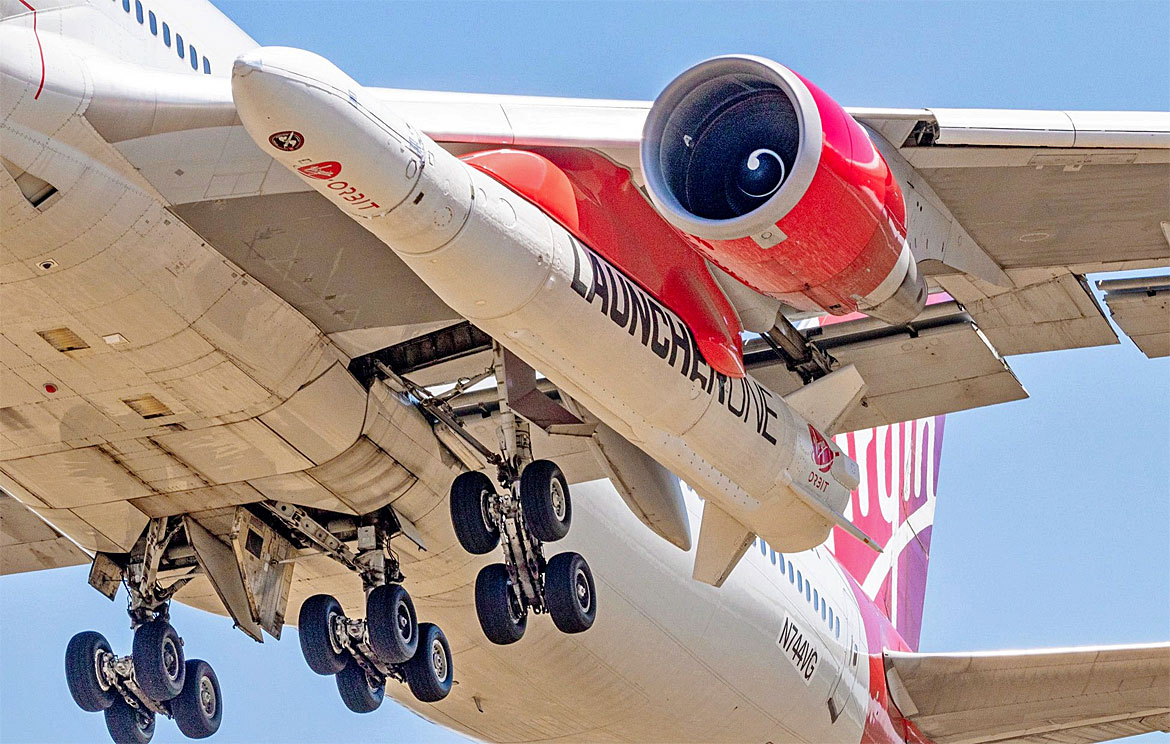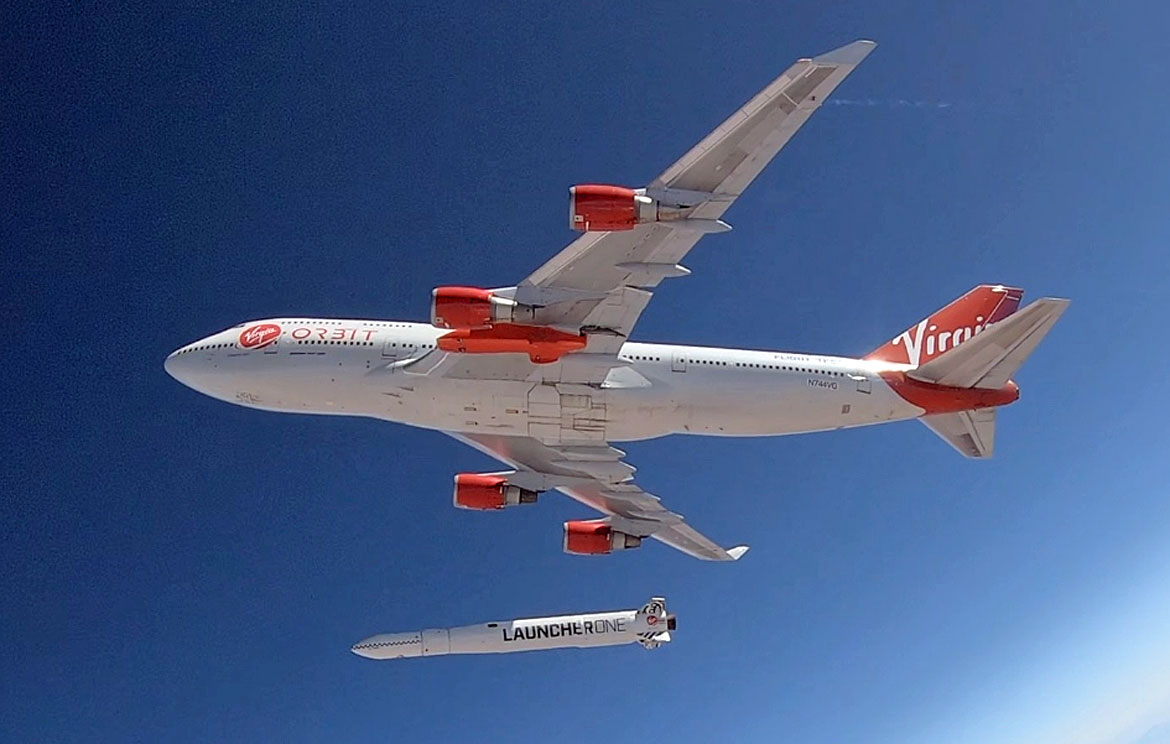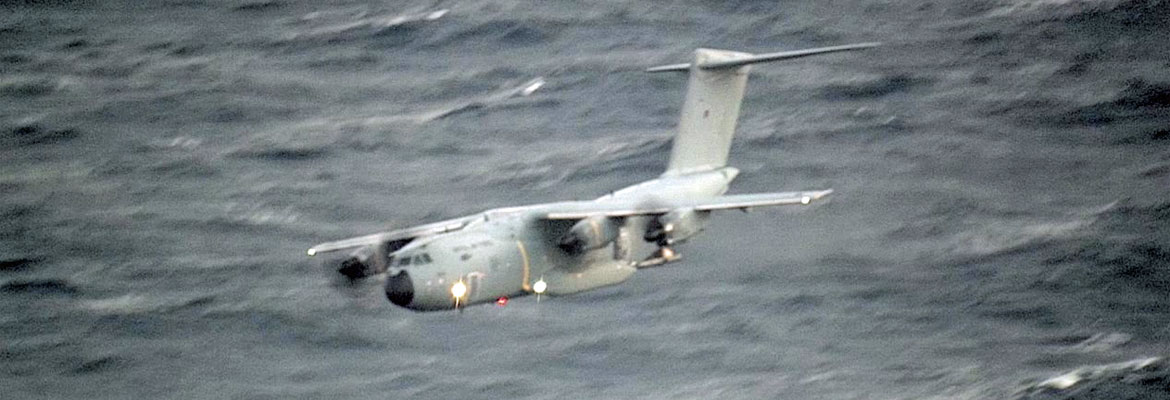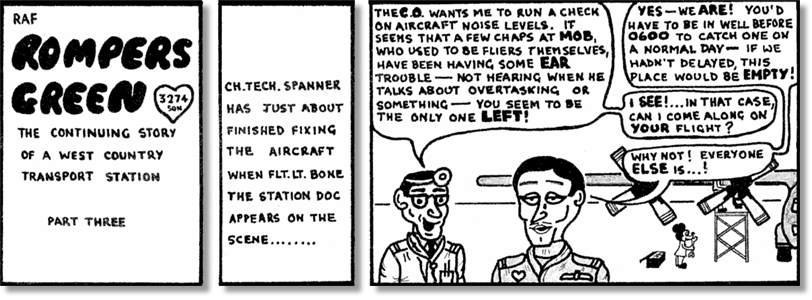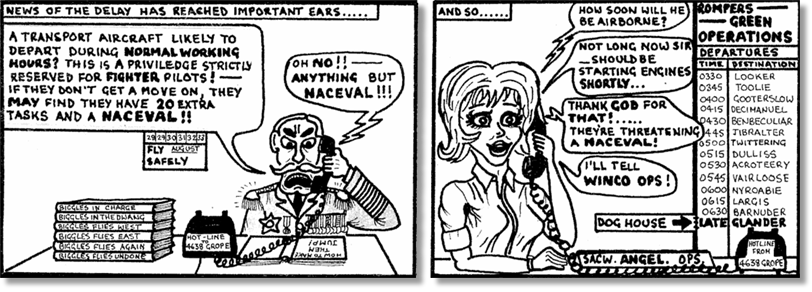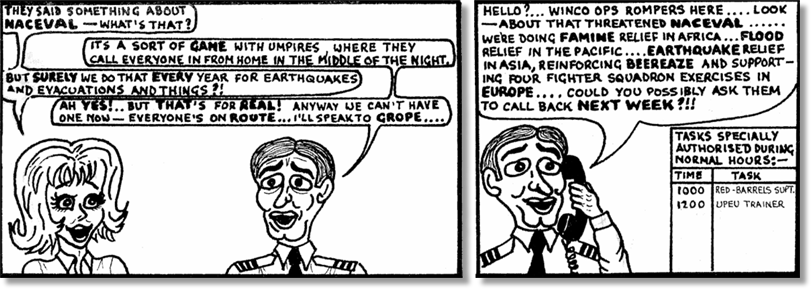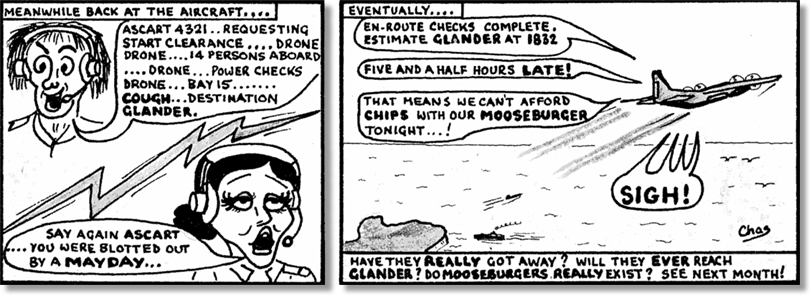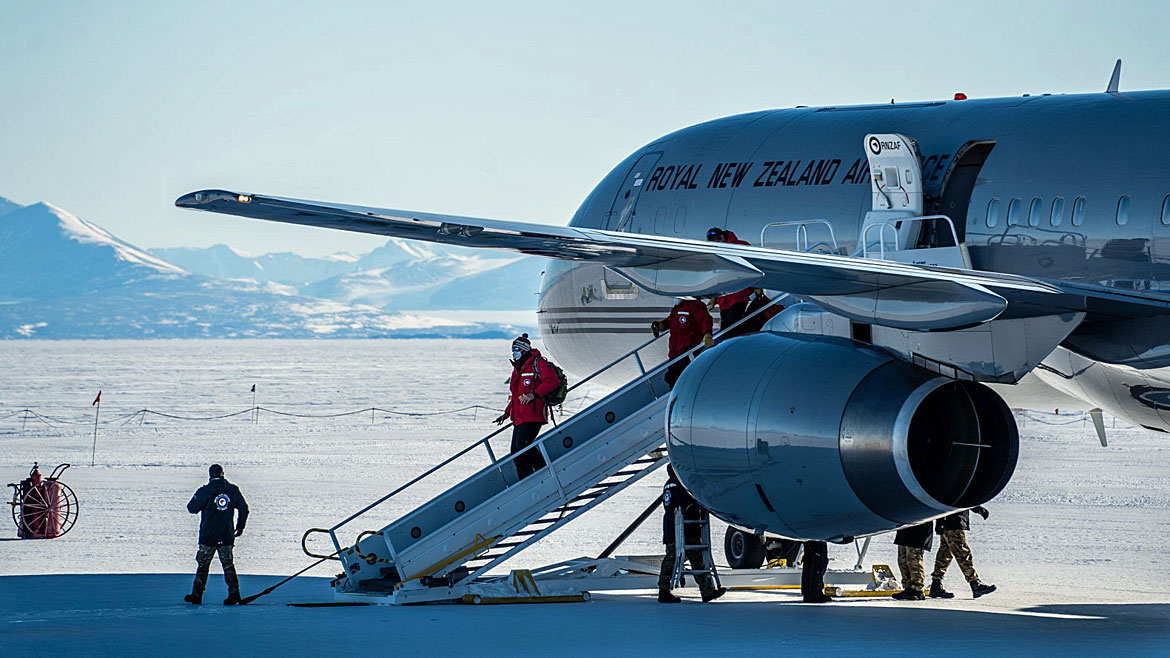
From: Tony Gale, Gatineau, QC
Subject: Britannia engines
Hi Roger,
I suspect this happened during the Zambian Oil Lift (1965-66)
It's entirely possible - but I somehow doubt that it was the LM's idea - it's in my mind that there would have been a MAMS team there with the BFLP (Britannia Freight Lift Platform). Perhaps Jerry Porter or Ian Stacey can shed some light on it? Also, back in the day, the RAF Loadmaster was known as an Air Quartermaster (QM/AQM).
Regards,
Tony
Subject: Britannia engines
Hi Roger,
I suspect this happened during the Zambian Oil Lift (1965-66)
It's entirely possible - but I somehow doubt that it was the LM's idea - it's in my mind that there would have been a MAMS team there with the BFLP (Britannia Freight Lift Platform). Perhaps Jerry Porter or Ian Stacey can shed some light on it? Also, back in the day, the RAF Loadmaster was known as an Air Quartermaster (QM/AQM).
Regards,
Tony


RAF C-17 delivers rocket ahead of first UK space launch
Ahead of the first launch from UK soil, Virgin Orbit’s converted Boeing 747 launch vehicle ‘Cosmic Girl’ this week touched down at Spaceport Cornwall, Cornwall Airport Newquay. In addition, the C-17 carrying the rocket to be launched by the 747 also landed.
Cosmic Girl will carry seven payloads into Lower Earth Orbit from Cornwall via the LauncherOne rocket on the aptly named “Start Me Up” mission; Virgin Orbit’s first international launch. The missions of these satellites span a wide range of activities aimed at improving life on planet Earth, including reducing the environmental impact of production, preventing illegal trafficking, smuggling, and terrorism; and a host of national security functions.
This week payloads have begun integration into Virgin Orbit’s launch system from the state-of-the-art Space Systems Integration Facility, the recent opening of which heralded a new era of capability within UK small satellite services. Virgin Orbit has been working closely with the United Kingdom’s Civil Aviation Authority (CAA), the Royal Air Force (RAF), and the Spaceport Cornwall team to make all necessary preparations for lift-off.
Squadron Leader Matthew Stannard, Chief Pilot, Virgin Orbit, was quoted as saying: “It feels amazing to bring Cosmic Girl home to the UK. We are weeks away now from the first UK launch at Spaceport Cornwall so it’s all very real, I’m really excited to be here with the Virgin Orbit team.” [RAF pilot seconded to Virgin Orbit space programme]
Melissa Thorpe, Head of Spaceport Cornwall welcomed Cosmic Girl to Spaceport Cornwall said: “This is the moment we have been waiting eight years for and my team could not be more excited to welcome Cosmic Girl to the UK. A converted 747 using a converted airport to get to space is a perfect example of what we are working to achieve at Spaceport Cornwall. By making use of existing assets we want to set the bar for responsible launch – Starting Up launch in the UK with ‘Space For Good’ at its core.”
Matt Archer, Director of Commercial Spaceflight at the UK Space Agency, said: “Watching a 747 land is always impressive, but everyone had goosebumps as Cosmic Girl touched down on the runway at Spaceport Cornwall for the first time. We are now a matter of weeks away from launch and, while the excitement is building, teams on the ground continue to work hard on the preparations. More equipment, including the rocket, will arrive in the coming days and the delicate task of integrating the satellites will begin. We have never done this before in the UK, it is a complex and technically challenging endeavour, and I’m confident in the capabilities of our partners at Virgin Orbit and Spaceport Cornwall to deliver a successful mission.”
A spokesperson from 99 Squadron ("You call, we haul") stated: "Great to be part of this, bringing Virgin Orbit’s ‘LauncherOne’ to the UK last night on a C-17. Certainly one of the more different loads our excellent Air Loadmasters and Movers have transported."
The launch is on track for November.
UK Defence Journal
Cosmic Girl will carry seven payloads into Lower Earth Orbit from Cornwall via the LauncherOne rocket on the aptly named “Start Me Up” mission; Virgin Orbit’s first international launch. The missions of these satellites span a wide range of activities aimed at improving life on planet Earth, including reducing the environmental impact of production, preventing illegal trafficking, smuggling, and terrorism; and a host of national security functions.
This week payloads have begun integration into Virgin Orbit’s launch system from the state-of-the-art Space Systems Integration Facility, the recent opening of which heralded a new era of capability within UK small satellite services. Virgin Orbit has been working closely with the United Kingdom’s Civil Aviation Authority (CAA), the Royal Air Force (RAF), and the Spaceport Cornwall team to make all necessary preparations for lift-off.
Squadron Leader Matthew Stannard, Chief Pilot, Virgin Orbit, was quoted as saying: “It feels amazing to bring Cosmic Girl home to the UK. We are weeks away now from the first UK launch at Spaceport Cornwall so it’s all very real, I’m really excited to be here with the Virgin Orbit team.” [RAF pilot seconded to Virgin Orbit space programme]
Melissa Thorpe, Head of Spaceport Cornwall welcomed Cosmic Girl to Spaceport Cornwall said: “This is the moment we have been waiting eight years for and my team could not be more excited to welcome Cosmic Girl to the UK. A converted 747 using a converted airport to get to space is a perfect example of what we are working to achieve at Spaceport Cornwall. By making use of existing assets we want to set the bar for responsible launch – Starting Up launch in the UK with ‘Space For Good’ at its core.”
Matt Archer, Director of Commercial Spaceflight at the UK Space Agency, said: “Watching a 747 land is always impressive, but everyone had goosebumps as Cosmic Girl touched down on the runway at Spaceport Cornwall for the first time. We are now a matter of weeks away from launch and, while the excitement is building, teams on the ground continue to work hard on the preparations. More equipment, including the rocket, will arrive in the coming days and the delicate task of integrating the satellites will begin. We have never done this before in the UK, it is a complex and technically challenging endeavour, and I’m confident in the capabilities of our partners at Virgin Orbit and Spaceport Cornwall to deliver a successful mission.”
A spokesperson from 99 Squadron ("You call, we haul") stated: "Great to be part of this, bringing Virgin Orbit’s ‘LauncherOne’ to the UK last night on a C-17. Certainly one of the more different loads our excellent Air Loadmasters and Movers have transported."
The launch is on track for November.
UK Defence Journal

From: Mark Attrill, Tallinn
Subject: Letter from Estonia - 8 October 2022
Tony,
Yesterday was the end of an era for me and ironically fell on President Putin's birthday. My 'birthday surprise for him' was to present Lieutenant Colonel Pavlo X (A Ukrainian Officer currently undertaking our long course) with a large box containing enough Cold and Warm Weather combat uniform items to fully equip a member of the Ukrainian Armed Forces. This included several sets of MTP (disruptive pattern) shirts/trousers, overjacket, gloves, cold weather socks, thermal liners and boots, most of which were brand new and never worn. I never imagined that on final 'Demob' this is where my military clothing was destined for, but so be it. These were the last items of UK combat uniform I owned and I very much hope they can be put to good use. I retained one pair of old boots should I ever be 'called up' by the Estonian Defence League (equivalent to the TA) who will issue me with their own uniform should the need arise.
We are currently heartened by the fact that no less than seven members of the Ukrainian Armed Forces are resident in the college on long term courses and over the past two weeks they were joined by a further 8 Officers on short courses or visits - To have 15 representatives of the AFU in the college at one time speaks volumes for their confidence going forward, and we are not the only NATO /Allied entity hosting AFU representatives at this time.
On a separate note, I wanted to add some anecdotes regarding the late WO Mick Day and his time with me at Coltishall. We in the Flight had always considered Mick to have much in common with the legendary England Footballer and commentator, Jimmy 'Greavsie' Greaves. I am not sure if Mick had suspected this but he, more often than not, made references to "Funny Old Deployments" (older readers will get this) during the preparatory phases, which raised a furtive smile or two from the rest of the team on MSF.
On one Monday morning, I remember Mick arriving for work rather sheepishly with a scarf around his neck/lower face. In those days, we shared an office since the MSF did not enjoy much in the way of office accommodation. Eventually he had to remove the garment and I remember saying something along the lines of "What the Hell, Mick! - did you get beaten up over the weekend?", since his face bore some rather nasty red scars. He had gone home to Gloucestershire for the weekend and had bought some donuts that had turned out to be a bit stale. He popped them in the microwave (a rather new addition to most kitchens in those days) and forgot about the hot jam that would spew out once he took a bite. It went all over his face and he was lucky not to have to visit A&E.
As I said previously, Mick was initially not that enamored with his posting to RAF Coltishall but soon grew to like the new environment and challenge and given the nature of my duties as the OC, which took me away from base for a large part of the year, he quickly gained the trust and respect of the Station Management. I was posted before the end of his own tenure and, as I understand it, he was quite reluctant to go. Another good egg that has entered that 'crewroom in the sky' to which we will all eventually go. RIP Mick Day
Cheers
Mark A
Subject: Letter from Estonia - 8 October 2022
Tony,
Yesterday was the end of an era for me and ironically fell on President Putin's birthday. My 'birthday surprise for him' was to present Lieutenant Colonel Pavlo X (A Ukrainian Officer currently undertaking our long course) with a large box containing enough Cold and Warm Weather combat uniform items to fully equip a member of the Ukrainian Armed Forces. This included several sets of MTP (disruptive pattern) shirts/trousers, overjacket, gloves, cold weather socks, thermal liners and boots, most of which were brand new and never worn. I never imagined that on final 'Demob' this is where my military clothing was destined for, but so be it. These were the last items of UK combat uniform I owned and I very much hope they can be put to good use. I retained one pair of old boots should I ever be 'called up' by the Estonian Defence League (equivalent to the TA) who will issue me with their own uniform should the need arise.
We are currently heartened by the fact that no less than seven members of the Ukrainian Armed Forces are resident in the college on long term courses and over the past two weeks they were joined by a further 8 Officers on short courses or visits - To have 15 representatives of the AFU in the college at one time speaks volumes for their confidence going forward, and we are not the only NATO /Allied entity hosting AFU representatives at this time.
On a separate note, I wanted to add some anecdotes regarding the late WO Mick Day and his time with me at Coltishall. We in the Flight had always considered Mick to have much in common with the legendary England Footballer and commentator, Jimmy 'Greavsie' Greaves. I am not sure if Mick had suspected this but he, more often than not, made references to "Funny Old Deployments" (older readers will get this) during the preparatory phases, which raised a furtive smile or two from the rest of the team on MSF.
On one Monday morning, I remember Mick arriving for work rather sheepishly with a scarf around his neck/lower face. In those days, we shared an office since the MSF did not enjoy much in the way of office accommodation. Eventually he had to remove the garment and I remember saying something along the lines of "What the Hell, Mick! - did you get beaten up over the weekend?", since his face bore some rather nasty red scars. He had gone home to Gloucestershire for the weekend and had bought some donuts that had turned out to be a bit stale. He popped them in the microwave (a rather new addition to most kitchens in those days) and forgot about the hot jam that would spew out once he took a bite. It went all over his face and he was lucky not to have to visit A&E.
As I said previously, Mick was initially not that enamored with his posting to RAF Coltishall but soon grew to like the new environment and challenge and given the nature of my duties as the OC, which took me away from base for a large part of the year, he quickly gained the trust and respect of the Station Management. I was posted before the end of his own tenure and, as I understand it, he was quite reluctant to go. Another good egg that has entered that 'crewroom in the sky' to which we will all eventually go. RIP Mick Day
Cheers
Mark A

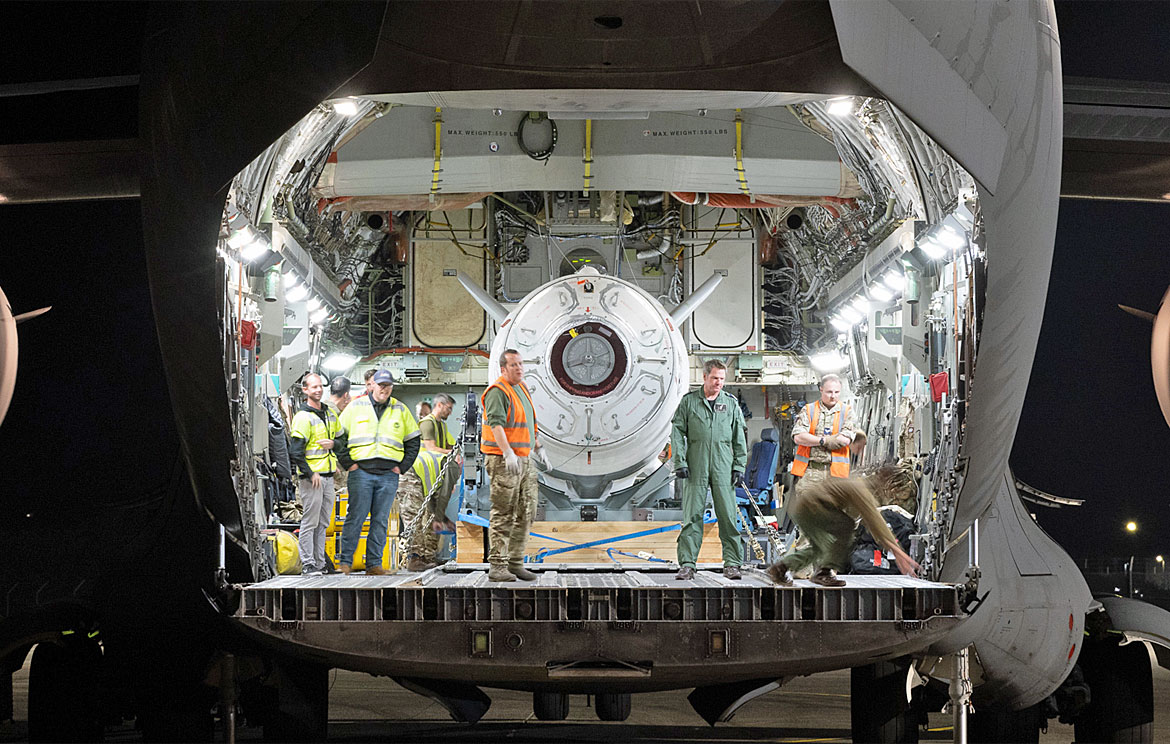

From: Roger Whittington, Prescot, Merseyside
Subject: Britannia engines
Hi Tony,
This letter appeared in the latest Air Mail magazine. Is the action described here possible? As someone who only joined up in 1974 this is all a bit too early for me.
Cheers now,
Roger
Subject: Britannia engines
Hi Tony,
This letter appeared in the latest Air Mail magazine. Is the action described here possible? As someone who only joined up in 1974 this is all a bit too early for me.
Cheers now,
Roger

No Comment
In 1965 when I was an Air Loadmaster, I was deployed to Nairobi in Kenya. One day we had two Britannia aircraft due for an engine change, so two aircraft arrived with the new engines on board. To offload the engines a lift platform was supplied and all was going well until we discovered that the cable required to power the platform was missing.
I knew that there was a Coles crane at Nairobi airport and a heavy duty forklift at nearby RAF Embakasi which was sent for post-haste. However, the engines we intended to offload were heavier than the limit allowed by the extended forklift. By carefully positioning the Coles crane's bumper bar over the back of the forklift to prevent it tipping, we slowly offloaded both engines without incident.
During the debrief, the Wing Commander asked how I'd managed to get the engines off. "Sir," I replied, "if I tell you I'm afraid you'll have to Court Martial me!"
John Sankey
In 1965 when I was an Air Loadmaster, I was deployed to Nairobi in Kenya. One day we had two Britannia aircraft due for an engine change, so two aircraft arrived with the new engines on board. To offload the engines a lift platform was supplied and all was going well until we discovered that the cable required to power the platform was missing.
I knew that there was a Coles crane at Nairobi airport and a heavy duty forklift at nearby RAF Embakasi which was sent for post-haste. However, the engines we intended to offload were heavier than the limit allowed by the extended forklift. By carefully positioning the Coles crane's bumper bar over the back of the forklift to prevent it tipping, we slowly offloaded both engines without incident.
During the debrief, the Wing Commander asked how I'd managed to get the engines off. "Sir," I replied, "if I tell you I'm afraid you'll have to Court Martial me!"
John Sankey


From: Don Hunter, Saint Quentin de Caplong
Subject: Chris Cahill?
Hi Tony,
Going through a load of old pics and I wonder if you have any contact or news of Chris Cahill? I don’t see him on the directory or Facebook.
I’m currently working in Delhi - you can’t keep old Movers down!
All best wishes
Don
Subject: Chris Cahill?
Hi Tony,
Going through a load of old pics and I wonder if you have any contact or news of Chris Cahill? I don’t see him on the directory or Facebook.
I’m currently working in Delhi - you can’t keep old Movers down!
All best wishes
Don


Honour for RAF Pilot

From: Chris Goss, Marlow, Bucks
Subject: Turbulence
Tony,
The only experience I had with turbulence was flying back to the UK from Cyprus in 1995. Daughter and self were flying Business Class with Cyprus Airways (one of the perks of being OC JABC - those days long gone now!). We were both strapped in when it happened - screams from all around apart from five-year-old daughter shouting, "That was brilliant! Do it again!"
Regards
Chris
Subject: Turbulence
Tony,
The only experience I had with turbulence was flying back to the UK from Cyprus in 1995. Daughter and self were flying Business Class with Cyprus Airways (one of the perks of being OC JABC - those days long gone now!). We were both strapped in when it happened - screams from all around apart from five-year-old daughter shouting, "That was brilliant! Do it again!"
Regards
Chris


From: David Bernard, Bicester, Oxon
Subject: Turbulence
Hi Tony,
Currently on the high seas enjoying a cruise but here is a tale that gives me goosebumps whenever I go into “when I” mode.
In mid-1971, I was attached to 216 Squadron, (playing truant from an exciting SCAF tour), which was operating Comet 4Cs at that time. We were away on what was termed a “proving flight” (aka “Jolly”) transiting between Sri Lanka and Gan at around 38,000ft with just operating and ground crew aboard. I held the imprest and was head gopher for this six-week long task.
Very suddenly the aircraft descended like an express lift. None of us were strapped in and so became weightless for what seemed like ages and then THUD, we all hit the floor and seats as we lost more than 8,000ft in what seemed like just a few seconds. All four engines had flamed out. There was only the Nav and a non-current pilot sitting in the LH seat. The Sqn Boss, Basil D’Oliveira, had been pounding his typewriter generating another TRANSOP signal.
Amazingly there were just cuts and bruises and no broken bones. It took another five or so minutes to re-light one engine and the remaining three over the next 15 minutes by which time we were below 5,000ft with the front end crew working hard to kill the myriad of flashing lights and convert our downward trajectory into lift. A MAYDAY signal went out from the Nav (Ian Strike) in the hope of alerting the Marine Craft boys at Gan in the event we were to become swimmers rather than aviators.
The bad news was that one of the ALMs , Pete Wentworth, went into the dome freight bay to discover why it smelt like happy hour, to return and tell us all that our duty-free liquor had become a major casualty. The two ground-eng guys took some of the internal panels off to discover that the meters had gone “into the red”, and that the airframe had sustained severe fatigue stress and so a very, very gentle landing was made at Gan.
It required a large team of engineers to come out from the UK to carry out non-destructive testing on the wings and main spar areas during which we had nearly three weeks of unaccompanied service on Gan. We were all very pleased to be alive.
Best Wishes,
Dave
Subject: Turbulence
Hi Tony,
Currently on the high seas enjoying a cruise but here is a tale that gives me goosebumps whenever I go into “when I” mode.
In mid-1971, I was attached to 216 Squadron, (playing truant from an exciting SCAF tour), which was operating Comet 4Cs at that time. We were away on what was termed a “proving flight” (aka “Jolly”) transiting between Sri Lanka and Gan at around 38,000ft with just operating and ground crew aboard. I held the imprest and was head gopher for this six-week long task.
Very suddenly the aircraft descended like an express lift. None of us were strapped in and so became weightless for what seemed like ages and then THUD, we all hit the floor and seats as we lost more than 8,000ft in what seemed like just a few seconds. All four engines had flamed out. There was only the Nav and a non-current pilot sitting in the LH seat. The Sqn Boss, Basil D’Oliveira, had been pounding his typewriter generating another TRANSOP signal.
Amazingly there were just cuts and bruises and no broken bones. It took another five or so minutes to re-light one engine and the remaining three over the next 15 minutes by which time we were below 5,000ft with the front end crew working hard to kill the myriad of flashing lights and convert our downward trajectory into lift. A MAYDAY signal went out from the Nav (Ian Strike) in the hope of alerting the Marine Craft boys at Gan in the event we were to become swimmers rather than aviators.
The bad news was that one of the ALMs , Pete Wentworth, went into the dome freight bay to discover why it smelt like happy hour, to return and tell us all that our duty-free liquor had become a major casualty. The two ground-eng guys took some of the internal panels off to discover that the meters had gone “into the red”, and that the airframe had sustained severe fatigue stress and so a very, very gentle landing was made at Gan.
It required a large team of engineers to come out from the UK to carry out non-destructive testing on the wings and main spar areas during which we had nearly three weeks of unaccompanied service on Gan. We were all very pleased to be alive.
Best Wishes,
Dave


From: Ian Place, Meanwood, West Yorks
Subject: Not about Turbulence
Tony,
My story is not about turbulence, but may be interesting to your readers. In October 1973, Hotel team were flying on a Far East round trip in Hercules XV222 - the captain was Flt Lt Law of 48 Squadron. We were supporting Operation Briglog, transporting some Gurkhas from Hong Kong back to Nepal. Our route took us from Lyneham to Akrotiri (Night Stop) - Gan (NS) - Kai Tak (2 x NS) - Calcutta (Fuel Stop) - Kathmandu (NS) -Delhi (FS) -Masirah (NS) - Akrotiri (NS) - Lyneham.
Out of Gan we became tech with a dicky radio. I had already set up my net plus sleeping bag on the ramp and was just drifting off to sleep when the Loadie roughly shook me and told me to get back to the side para seat. I looked over a saw he had left his headset plugged in to the system and for 35 minutes I listened to ATC and the flight crew comms. When he came back to get his headset he admonished me for doing his job! It took 65 minutes for us to dump fuel and land back at Gan for something a civilian pilot would have ignored and carried on with the flight. It took just 45 minutes to fix the problem. Needless to say I did not go back and re-rig my cargo net hammock and it took 11 hours to get to Kai Tak.
Happy days!
Ian
Subject: Not about Turbulence
Tony,
My story is not about turbulence, but may be interesting to your readers. In October 1973, Hotel team were flying on a Far East round trip in Hercules XV222 - the captain was Flt Lt Law of 48 Squadron. We were supporting Operation Briglog, transporting some Gurkhas from Hong Kong back to Nepal. Our route took us from Lyneham to Akrotiri (Night Stop) - Gan (NS) - Kai Tak (2 x NS) - Calcutta (Fuel Stop) - Kathmandu (NS) -Delhi (FS) -Masirah (NS) - Akrotiri (NS) - Lyneham.
Out of Gan we became tech with a dicky radio. I had already set up my net plus sleeping bag on the ramp and was just drifting off to sleep when the Loadie roughly shook me and told me to get back to the side para seat. I looked over a saw he had left his headset plugged in to the system and for 35 minutes I listened to ATC and the flight crew comms. When he came back to get his headset he admonished me for doing his job! It took 65 minutes for us to dump fuel and land back at Gan for something a civilian pilot would have ignored and carried on with the flight. It took just 45 minutes to fix the problem. Needless to say I did not go back and re-rig my cargo net hammock and it took 11 hours to get to Kai Tak.
Happy days!
Ian


Two RAF aircraft help rescue stricken sailor in 19ft waves
Two RAF aircraft were involved in the rescue of a stricken sailor from the Atlantic Ocean off the coast of Scotland after his yacht lost its mast in stormy conditions. A Poseidon P8 from RAF Lossiemouth, which is known for hunting submarines and an Atlas A400M aircraft from RAF Brize Norton, were tasked in the rescue of the distressed sailor whose ship had lost its mast.
The ship was struggling in waves higher than 19ft, midway between the UK and Greenland. The 120 Squadron Poseidon P-8 Maritime Patrol Aircraft used its advanced surface search capabilities to locate the stricken yacht amongst the high waves. They then coordinated with the Atlas from 70 Squadron, enabling it to visually check the area and locate the yacht. The P-8 then made radio contact with the sailor confirming that he was uninjured.
The Atlas dropped their Air Sea Rescue Apparatus (ASRA) to the yacht through a rear ramp drop, where it descended via parachute. The rescue pack was retrieved by the yachtsman who remained under the watchful eye of the Poseidon aircraft while the Atlas returned to RAF Brize Norton.
The Poseidon was subsequently used for a second mission overnight to assist merchant vessels, which travelled 120 miles off their planned route to recover the sailor. The sailor was recovered the following morning by one of the vessels and is now being treated for minor injuries.
The Atlas captain, Flt Lt Mainwaring, described his enormous sense of relief at a successful rescue. He said: “The team at RAF Brize Norton was simply superb, it really felt like they were propelling us into the air with a shared sense of purpose and mission. Similarly, knowing the Poseidon was on station provided not only a huge amount of additional capability but also re-enforced that the RAF team was collectively working to rescue this stranded individual.”
He continued, “There was huge relief when we confirmed the location of the yacht. There was a sense of purpose as we prepared to release the rescue equipment because you only get one chance to get it right. Seeing the yachtsman recover the equipment we dropped was brilliant. I am incredibly proud of Team Atlas today, with the whole force helping to deliver emergency equipment at very short notice and under challenging conditions. It is a timely reminder of why we hold constant readiness and of the tremendous reach and capabilities of the Atlas aircraft.”
stv.tv/Forces News
The ship was struggling in waves higher than 19ft, midway between the UK and Greenland. The 120 Squadron Poseidon P-8 Maritime Patrol Aircraft used its advanced surface search capabilities to locate the stricken yacht amongst the high waves. They then coordinated with the Atlas from 70 Squadron, enabling it to visually check the area and locate the yacht. The P-8 then made radio contact with the sailor confirming that he was uninjured.
The Atlas dropped their Air Sea Rescue Apparatus (ASRA) to the yacht through a rear ramp drop, where it descended via parachute. The rescue pack was retrieved by the yachtsman who remained under the watchful eye of the Poseidon aircraft while the Atlas returned to RAF Brize Norton.
The Poseidon was subsequently used for a second mission overnight to assist merchant vessels, which travelled 120 miles off their planned route to recover the sailor. The sailor was recovered the following morning by one of the vessels and is now being treated for minor injuries.
The Atlas captain, Flt Lt Mainwaring, described his enormous sense of relief at a successful rescue. He said: “The team at RAF Brize Norton was simply superb, it really felt like they were propelling us into the air with a shared sense of purpose and mission. Similarly, knowing the Poseidon was on station provided not only a huge amount of additional capability but also re-enforced that the RAF team was collectively working to rescue this stranded individual.”
He continued, “There was huge relief when we confirmed the location of the yacht. There was a sense of purpose as we prepared to release the rescue equipment because you only get one chance to get it right. Seeing the yachtsman recover the equipment we dropped was brilliant. I am incredibly proud of Team Atlas today, with the whole force helping to deliver emergency equipment at very short notice and under challenging conditions. It is a timely reminder of why we hold constant readiness and of the tremendous reach and capabilities of the Atlas aircraft.”
stv.tv/Forces News
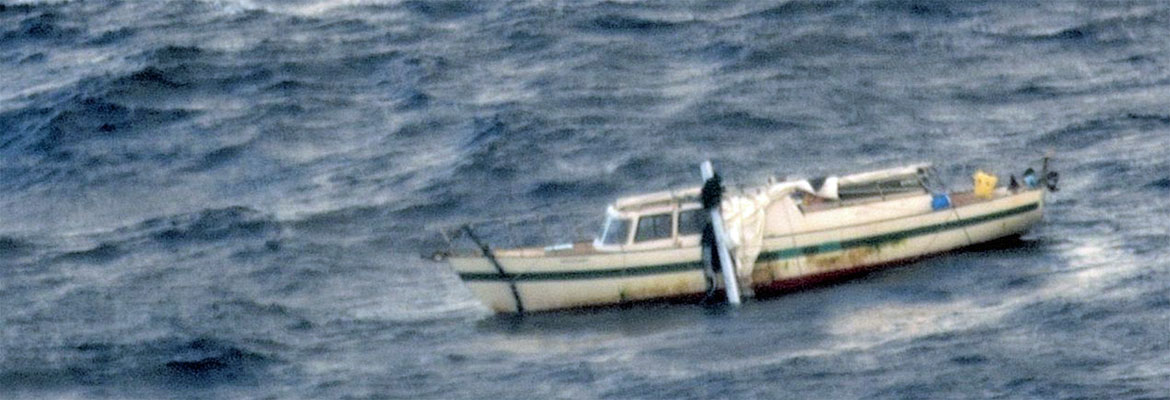

From: Barry Tappenden, Shortstown, Beds
Subject: Turbulence
Hi Tony,
Flying back in a Beverley from Hong Kong after an exhausting few days, we encountered a severe storm. I fortunately wanted a few z’s so had strapped myself in. My fellow team mates weren’t so lucky, like you on the pallets; we dropped like a stone and a couple left their seats and “kissed” the roof, no injuries thank goodness but I think the AQM spilt his coffee!
Regards
Barry
Subject: Turbulence
Hi Tony,
Flying back in a Beverley from Hong Kong after an exhausting few days, we encountered a severe storm. I fortunately wanted a few z’s so had strapped myself in. My fellow team mates weren’t so lucky, like you on the pallets; we dropped like a stone and a couple left their seats and “kissed” the roof, no injuries thank goodness but I think the AQM spilt his coffee!
Regards
Barry


From: Clive Price, Brecon
Subject: Turbulence
Hello Tony,
Foxtrot Team flew a company of Nigerian soldiers back home after their training in Scotland. Nearing Africa, we hit an air pocket and dropped about 2,000ft. The howl that went through the aircraft drowned out the sound of the engines followed closely by the rattle of rosary beads, which did the same! (I'm sure one of the rattlers was our old team mate, Irish Jack Murray.)
After we landed and headed to the hotel, the operating crew decided that they wouldn't go two to a room (as would have been the proper thing to do), so there being no more available rooms the MAMS team were kicked out and we had to find another hotel. Many hours later we found a bed for the night; no dinner, no breakfast and a 9am takeoff.
The return leg had a very grumpy Foxtrot Team!
Clive (Taff)
Subject: Turbulence
Hello Tony,
Foxtrot Team flew a company of Nigerian soldiers back home after their training in Scotland. Nearing Africa, we hit an air pocket and dropped about 2,000ft. The howl that went through the aircraft drowned out the sound of the engines followed closely by the rattle of rosary beads, which did the same! (I'm sure one of the rattlers was our old team mate, Irish Jack Murray.)
After we landed and headed to the hotel, the operating crew decided that they wouldn't go two to a room (as would have been the proper thing to do), so there being no more available rooms the MAMS team were kicked out and we had to find another hotel. Many hours later we found a bed for the night; no dinner, no breakfast and a 9am takeoff.
The return leg had a very grumpy Foxtrot Team!
Clive (Taff)


The captain closed the chess set and indicated for me to go back to my position in the back of the aircraft. I did so, and told the young co-pilot that he was wanted back on the flight deck.
I took up my seat again and fastened my seatbelt, as the buffeting was getting worse. It continued to get worse and I noticed that with the more violent bumps, our 3,360 lbs cooling-trolley was beginning to dance on its springs.
I took up my seat again and fastened my seatbelt, as the buffeting was getting worse. It continued to get worse and I noticed that with the more violent bumps, our 3,360 lbs cooling-trolley was beginning to dance on its springs.
From: Alex Masson, Tunbridge Wells, Kent
Subject: Turbulence
Dear Tony,
Hastings WD489 belonged to 24C Squadron from Lyneham/Colerne. The letter ‘C’ denoted the fact it was a ‘Commonwealth Squadron’ with a Canadian Captain, Flt Lt Alexander Sproule, and we were flying from Christmas Island to Edinburgh Field, in Australia, calling at Canton (a desert island in the Pacific) Fiji, Amberley, near to Brisbane, before going on to Edinburgh Field, and the Woomera Rocket Range. We were putting down oxygen cylinders for the Canberra's and Valliant's to come through, and a massive 3,360lbs air cooling trolley, to be placed at Fiji.
After landing at Canton, once airborne and back on course at our cruising height of 8,500 feet, I was called forward again by the captain to continue our game of chess. An hour or more later, I could see clouds ahead on the horizon, and as we approached they got bigger and bigger and blacker and blacker. Not a pretty sight! Our captain had also noticed this threateningly darkening sky, and after consultation with our navigator, altered course to port in an effort to get around this storm. Bear in mind, we had no forward-looking radar with which to warn us of such storms.
Although we had veered off, way to the left away from the centre of the maelstrom, it was too big to avoid completely. Soon we were entering cloud; light and wispy at first on the outer fringes of the storm. From our height of 8,500 feet, we could look up and see the immense mass of black boiling cloud towering twenty, thirty, forty thousand feet or more above us. Gradually the cloud thickened and we began to bump and sway. Gently at first but the turbulence slowly began to increase.
Subject: Turbulence
Dear Tony,
Hastings WD489 belonged to 24C Squadron from Lyneham/Colerne. The letter ‘C’ denoted the fact it was a ‘Commonwealth Squadron’ with a Canadian Captain, Flt Lt Alexander Sproule, and we were flying from Christmas Island to Edinburgh Field, in Australia, calling at Canton (a desert island in the Pacific) Fiji, Amberley, near to Brisbane, before going on to Edinburgh Field, and the Woomera Rocket Range. We were putting down oxygen cylinders for the Canberra's and Valliant's to come through, and a massive 3,360lbs air cooling trolley, to be placed at Fiji.
After landing at Canton, once airborne and back on course at our cruising height of 8,500 feet, I was called forward again by the captain to continue our game of chess. An hour or more later, I could see clouds ahead on the horizon, and as we approached they got bigger and bigger and blacker and blacker. Not a pretty sight! Our captain had also noticed this threateningly darkening sky, and after consultation with our navigator, altered course to port in an effort to get around this storm. Bear in mind, we had no forward-looking radar with which to warn us of such storms.
Although we had veered off, way to the left away from the centre of the maelstrom, it was too big to avoid completely. Soon we were entering cloud; light and wispy at first on the outer fringes of the storm. From our height of 8,500 feet, we could look up and see the immense mass of black boiling cloud towering twenty, thirty, forty thousand feet or more above us. Gradually the cloud thickened and we began to bump and sway. Gently at first but the turbulence slowly began to increase.
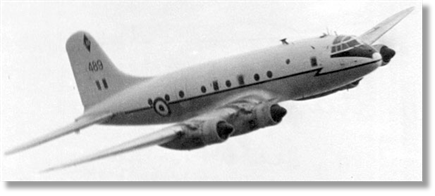

By lashing it down with chain and strainers when we loaded it, I had compressed the springs as much as I could. That was OK for normal flight, in smooth conditions, but now, with the violent bumping, the springs were being subjected to heavier loading.
Being compressed even more by the G-force, with the result that the chains were holding tight one minute, then being slackened the next. When the pressure bore down the loose chains clanked and groaned and jerked alarmingly. My immediate thoughts were, if this gets worse, we could burst a chain and once one goes others would follow. The breaking strain of our chains was one ton, 2,240lbs but we had a 3,360lb load and this weight would increase dramatically as the G-force kicked in.
More lashings, I thought! I must get more lashings on this brute! Luckily, there were plenty of spare chain and strainers at the back of the aircraft, all neatly clipped to the aircraft ribs.
I left my seat, grabbed handfuls of chain and strainers, and with difficulty started adding more lashings from the floor points to the trolley. The buffeting was now almost continuous, so I worked fast chaining and cranking up the strainers. Lying alongside and reaching underneath the trolley I was able to tighten more of the strainers, as the springs compressed, but had to mind my fingers as the chains snapped back under tension holding the load again. I kept thinking that the Board of Enquiry would blame the loss of the Hastings WD489 on the person who loaded it; for not ensuring that it was properly lashed down.
Seeing our predicament, the servicing corporal got down alongside me to assist and together we added more and more chain. By now the cloud was black – black as night and it was becoming difficult to see what we were doing except that the darkness was now being punctuated by vivid blue lights of lightning which illuminated the inside of the aeroplane.
Our Hastings was being tossed about mercilessly, and the noise of the clanking chains and the scream of the metal, as they took the strain was quite frightening. Blue lights were dancing everywhere! I was frightened! Very frightened! I kept thinking, if this load breaks loose, it will go right through the side of this aeroplane! This prompted me to work faster. I next remember the sergeant Air Quartermaster alongside me shouting, “More chain?” and I nodded furiously. The three of us now, on the floor, were being flung about, as we struggled to link up more chain, from the trolley to the floor. It was impossible to stand. We were reduced to crawling around the aircraft floor and frequently becoming weightless as we did so.
Heaven knows how long it took us, but eventually the trolley gave up dancing, the blue lights faded and gradually the ride became less turbulent. Suddenly, the sun broke through and we were out of the cloud. I thanked the two who had helped me on the floor, and we all smiled, as we noticed our two passengers were distinctly off colour. One was white as a sheet and the other was a pale shade of green.
We had made it to Nandi Airport in Fiji without mishap but that was the scariest and roughest flight I have ever experienced.
Regards,
Alex
Being compressed even more by the G-force, with the result that the chains were holding tight one minute, then being slackened the next. When the pressure bore down the loose chains clanked and groaned and jerked alarmingly. My immediate thoughts were, if this gets worse, we could burst a chain and once one goes others would follow. The breaking strain of our chains was one ton, 2,240lbs but we had a 3,360lb load and this weight would increase dramatically as the G-force kicked in.
More lashings, I thought! I must get more lashings on this brute! Luckily, there were plenty of spare chain and strainers at the back of the aircraft, all neatly clipped to the aircraft ribs.
I left my seat, grabbed handfuls of chain and strainers, and with difficulty started adding more lashings from the floor points to the trolley. The buffeting was now almost continuous, so I worked fast chaining and cranking up the strainers. Lying alongside and reaching underneath the trolley I was able to tighten more of the strainers, as the springs compressed, but had to mind my fingers as the chains snapped back under tension holding the load again. I kept thinking that the Board of Enquiry would blame the loss of the Hastings WD489 on the person who loaded it; for not ensuring that it was properly lashed down.
Seeing our predicament, the servicing corporal got down alongside me to assist and together we added more and more chain. By now the cloud was black – black as night and it was becoming difficult to see what we were doing except that the darkness was now being punctuated by vivid blue lights of lightning which illuminated the inside of the aeroplane.
Our Hastings was being tossed about mercilessly, and the noise of the clanking chains and the scream of the metal, as they took the strain was quite frightening. Blue lights were dancing everywhere! I was frightened! Very frightened! I kept thinking, if this load breaks loose, it will go right through the side of this aeroplane! This prompted me to work faster. I next remember the sergeant Air Quartermaster alongside me shouting, “More chain?” and I nodded furiously. The three of us now, on the floor, were being flung about, as we struggled to link up more chain, from the trolley to the floor. It was impossible to stand. We were reduced to crawling around the aircraft floor and frequently becoming weightless as we did so.
Heaven knows how long it took us, but eventually the trolley gave up dancing, the blue lights faded and gradually the ride became less turbulent. Suddenly, the sun broke through and we were out of the cloud. I thanked the two who had helped me on the floor, and we all smiled, as we noticed our two passengers were distinctly off colour. One was white as a sheet and the other was a pale shade of green.
We had made it to Nandi Airport in Fiji without mishap but that was the scariest and roughest flight I have ever experienced.
Regards,
Alex

PM Jacinda Ardern lands in Antarctica for Scott Base visit
Prime Minister Jacinda Ardern has safely landed in Antarctica for a visit, after being turned back yesterday due to bad weather. She is visiting the South Pole to celebrate the 65th anniversary of Scott Base - New Zealand’s Antarctic home - and the first full season of Antarctic research after two years of Covid-19 disruption.
Ardern landed in McMurdo Sound today [27th October] and is to travel to Scott Base via Hägglund snow vehicles. She will be there until Friday. The Prime Minister will see first-hand the research, environmental protection, conservation and operations undertaken by New Zealanders in Antarctica and experience the challenges of working on the ice. She will also see preliminary work for the estimated $344 million redevelopment of Scott Base, which will secure the future of the research hub for at least the next 50 years. The redevelopment is due to be completed in 2028.
Ardern, accompanied by partner Clarke Gayford, left for Scott Base at 10am yesterday but the Royal New Zealand Air Force C130 Hercules had to turn around as strong winds built and weather in the Antarctic deteriorated. The plane landed back in Christchurch shortly after 2pm.
Star News
Ardern landed in McMurdo Sound today [27th October] and is to travel to Scott Base via Hägglund snow vehicles. She will be there until Friday. The Prime Minister will see first-hand the research, environmental protection, conservation and operations undertaken by New Zealanders in Antarctica and experience the challenges of working on the ice. She will also see preliminary work for the estimated $344 million redevelopment of Scott Base, which will secure the future of the research hub for at least the next 50 years. The redevelopment is due to be completed in 2028.
Ardern, accompanied by partner Clarke Gayford, left for Scott Base at 10am yesterday but the Royal New Zealand Air Force C130 Hercules had to turn around as strong winds built and weather in the Antarctic deteriorated. The plane landed back in Christchurch shortly after 2pm.
Star News
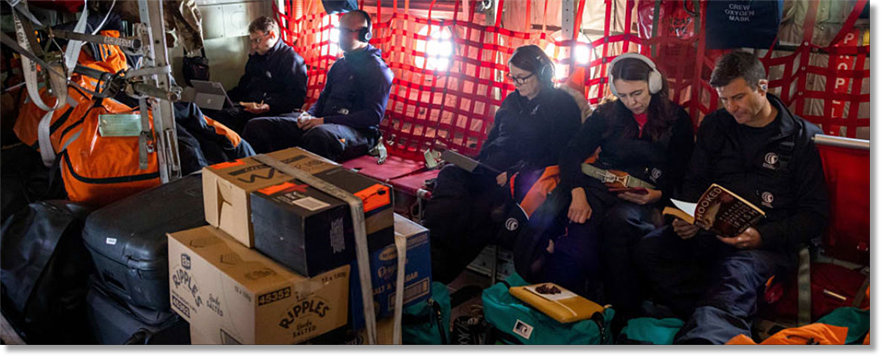
PM Jacinda Ardern (second from right) and partner Clarke Gayford aboard the RNZAF C130 Hercules

From: Andy Spinks, Falmouth, Cornwall
Subject: Two topics - Turbulence and Mick Day
Hi Tony,
Turbulence - To be honest, I have always been vulnerable to air sickness but am pleased to report that I never succumbed while on UKMAMS – it would not have been good for street creds! As a CCF cadet, though, circuits and bumps were never good, especially in the (then) new C130s and the old and bold Britannias, both of which had a strong plastic smell (C130s from the insulation and Britannias from the seats). But, that was not turbulence.
However, an approach into Dallas Fort Worth in a VC10 was. We were support crew on VC10, ASCOT 2520, in February 1979, routing Brize Norton - Edmonton - San Francisco - Dallas Fort Worth - Fort Campbell Army Base (Hopkinsville KY) - Charleston -Philadelphia - Bermuda - Brize Norton, with night-stops in Edmonton and Charleston. The load was for Fort Campbell Army Base but, looking at the flag-stops with hindsight, I guess it was also a trainer.
Anyway, letting down into DFW, we were told to strap in; for some reason we were all seated behind the freight and the female ALM was at the back as well. We were duly strapped in while the ALM did her final checks in the cabin. Suddenly, we hit severe turbulence. All of the items on the rack went up in the air and rained down upon us (strangely, I particularly remember a pair of shoes flying through the air). But, rather more spectacularly, the ALM did an impression of zero gravity, literally flying up and hitting the cabin roof before coming down with a thump onto the floor. I have never experienced anything like it before or since. Thankfully, she was not seriously injured but I would bet a healthy sum that she subsequently strapped in whenever told to do so.
There were other occasions when we encountered turbulence, particularly in the Far East, but nothing as bad as the Dallas event. As an aside, my usual remedy for potential motion sickness was - and still is - laying as horizontal as possible.
The only time since that I have embarrassed myself on a C130 was on the basic para course while OC Tactical Supply Wing (aka Tiswas). Three circuits of Weston-on-the-Green on a bumpy summer’s day before it was my turn to jump, sitting rigidly upright (wearing a parachute and with a heavy container between my legs), was too much for my inner ear and stomach. The Loadie kindly asked if I still wanted to jump to which I shouted “Yes, I just want to get out into the fresh air!” And so I did, and all was well with the world again as I floated down and prepared myself for the ground coming up to meet me – always more sudden and firm than I would have liked.
Mick Day - I wanted to write a few words by way of a eulogy for Mick Day. Mick was my sergeant for nearly all of my tour as F Troop Team Leader from 1975-79. F Troop was a very good and happy team, and this was primarily down to Mick’s gentle but invariably professional approach to whatever task we were on. However, I was particularly fortunate to spend a Gurkha Trooping season with Mick, from early September to Christmas 1976.
Many of you will know the Gurkha Trooping task was a detachment of just two people to handle the VC10s flying in from Hong Kong via Calcutta, night-stopping in Kathmandu, and then returning to Hong Kong at 1010 local the following morning. Mick and I not only worked together every day but also spent the downtime together because we were both accommodated (as was the VC10 crew) in the renowned Britannia House in Jawalakhel, Kathmandu. But there was never a cross word between us and we both loved the job, indeed we were extremely proud that, of the 52 departures from Kathmandu during our season there, every one of them left smack on time. It was professionally and personally very rewarding and I was privileged to have spent such a long time with such a good man. Mick will be sadly missed; may he rest in peace.
Andy
Subject: Two topics - Turbulence and Mick Day
Hi Tony,
Turbulence - To be honest, I have always been vulnerable to air sickness but am pleased to report that I never succumbed while on UKMAMS – it would not have been good for street creds! As a CCF cadet, though, circuits and bumps were never good, especially in the (then) new C130s and the old and bold Britannias, both of which had a strong plastic smell (C130s from the insulation and Britannias from the seats). But, that was not turbulence.
However, an approach into Dallas Fort Worth in a VC10 was. We were support crew on VC10, ASCOT 2520, in February 1979, routing Brize Norton - Edmonton - San Francisco - Dallas Fort Worth - Fort Campbell Army Base (Hopkinsville KY) - Charleston -Philadelphia - Bermuda - Brize Norton, with night-stops in Edmonton and Charleston. The load was for Fort Campbell Army Base but, looking at the flag-stops with hindsight, I guess it was also a trainer.
Anyway, letting down into DFW, we were told to strap in; for some reason we were all seated behind the freight and the female ALM was at the back as well. We were duly strapped in while the ALM did her final checks in the cabin. Suddenly, we hit severe turbulence. All of the items on the rack went up in the air and rained down upon us (strangely, I particularly remember a pair of shoes flying through the air). But, rather more spectacularly, the ALM did an impression of zero gravity, literally flying up and hitting the cabin roof before coming down with a thump onto the floor. I have never experienced anything like it before or since. Thankfully, she was not seriously injured but I would bet a healthy sum that she subsequently strapped in whenever told to do so.
There were other occasions when we encountered turbulence, particularly in the Far East, but nothing as bad as the Dallas event. As an aside, my usual remedy for potential motion sickness was - and still is - laying as horizontal as possible.
The only time since that I have embarrassed myself on a C130 was on the basic para course while OC Tactical Supply Wing (aka Tiswas). Three circuits of Weston-on-the-Green on a bumpy summer’s day before it was my turn to jump, sitting rigidly upright (wearing a parachute and with a heavy container between my legs), was too much for my inner ear and stomach. The Loadie kindly asked if I still wanted to jump to which I shouted “Yes, I just want to get out into the fresh air!” And so I did, and all was well with the world again as I floated down and prepared myself for the ground coming up to meet me – always more sudden and firm than I would have liked.
Mick Day - I wanted to write a few words by way of a eulogy for Mick Day. Mick was my sergeant for nearly all of my tour as F Troop Team Leader from 1975-79. F Troop was a very good and happy team, and this was primarily down to Mick’s gentle but invariably professional approach to whatever task we were on. However, I was particularly fortunate to spend a Gurkha Trooping season with Mick, from early September to Christmas 1976.
Many of you will know the Gurkha Trooping task was a detachment of just two people to handle the VC10s flying in from Hong Kong via Calcutta, night-stopping in Kathmandu, and then returning to Hong Kong at 1010 local the following morning. Mick and I not only worked together every day but also spent the downtime together because we were both accommodated (as was the VC10 crew) in the renowned Britannia House in Jawalakhel, Kathmandu. But there was never a cross word between us and we both loved the job, indeed we were extremely proud that, of the 52 departures from Kathmandu during our season there, every one of them left smack on time. It was professionally and personally very rewarding and I was privileged to have spent such a long time with such a good man. Mick will be sadly missed; may he rest in peace.
Andy

Mick Day and me plus the Britannia House staff and our driver on the day we left Kathmandu in December 1976
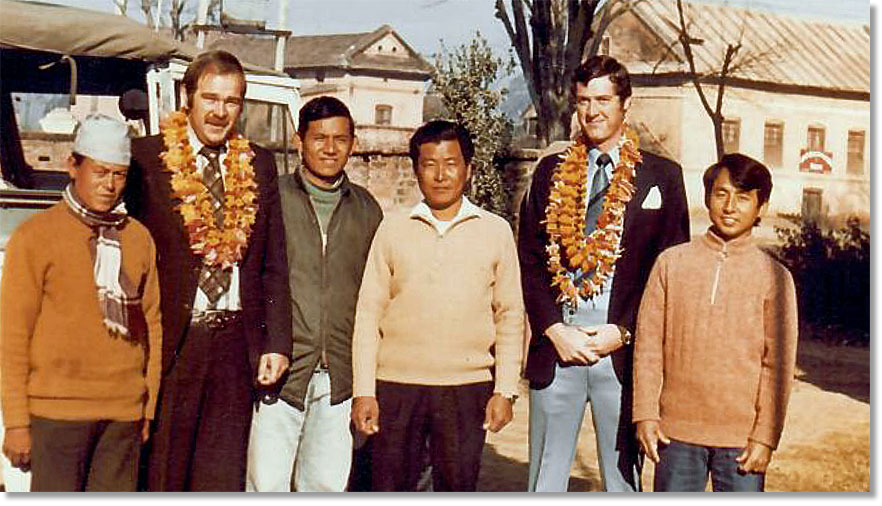

From: Ian Berry, Eastleaze, Swindon, Wilts
Subject: Turbulance
Hi Tony,
Not much to say on rocky flights, but worst encounter was on board a VC10 in June 1994 as part of Op Grapple. We were flying between Bruggen in Germany and Split, Croatia. Pretty much towards the end of the flight and over the Adriatic the aircraft must have dropped a couple of thousand feet. I was talking to the ALM at the time (old pal from C130 days) and he was catapulted backwards. He reappeared looking rather ashen and there was the odd scream from a couple of pax (am assuming female!). No permanent damage and we landed safely.
Some 20 years later, whilst sailing off Split and heading for Venice on a cruise ship, I encountered one of the most violent local storms I have ever experienced.
Ian
Subject: Turbulance
Hi Tony,
Not much to say on rocky flights, but worst encounter was on board a VC10 in June 1994 as part of Op Grapple. We were flying between Bruggen in Germany and Split, Croatia. Pretty much towards the end of the flight and over the Adriatic the aircraft must have dropped a couple of thousand feet. I was talking to the ALM at the time (old pal from C130 days) and he was catapulted backwards. He reappeared looking rather ashen and there was the odd scream from a couple of pax (am assuming female!). No permanent damage and we landed safely.
Some 20 years later, whilst sailing off Split and heading for Venice on a cruise ship, I encountered one of the most violent local storms I have ever experienced.
Ian


BREAKING NEWS - British fleet of C-130 Hercules aircraft put up for sale
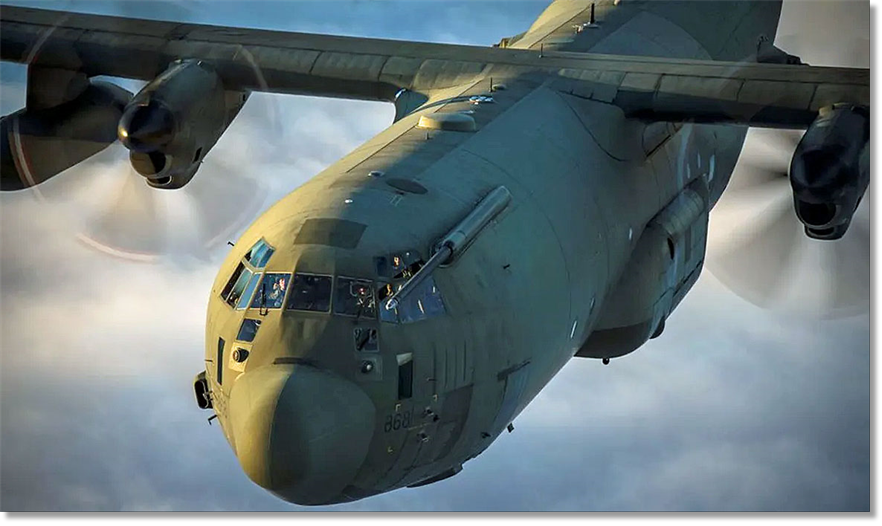
The Ministry of Defence has placed its fleet of 14 C-130 tactical airlifters up for sale ahead of the type being removed from service next year. The Royal Air Force will lose its entire fleet of C-130 Hercules aircraft by 2023 due to changes announced as part the Defence Command Paper, released in March last year, titled ‘Defence in a Competitive Age‘, which states:
“The Royal Air Force will retire the BAe146 as planned by 2022 and take the C130 Hercules out of service by 2023. The A400M Atlas force will increase its capacity and capability, operating alongside C 17 Globemaster and Voyager transport aircraft and tankers.”
The C-130J Hercules transport aircraft are often used by special forces and the C-130J variants first entered service with the Royal Air Force in the late 1990s and some of the C-130s have been retired in recent years, but the remaining 14 had originally been due to keep flying until the mid 2030s.
It is understood that, where possible, their missions will be picked up by the fleet of larger A400M Atlas transport aircraft. This defence review was previously described by then-Prime Minister Boris Johnson as the largest review of its kind since the Cold War.
The Defense Equipment Sales Authority (DESA) published the RAF’s C-130J Super Hercules on the list of surplus defence equipment available for sale.
The brochure states: The C-130J is the RAF’s primary tactical transport aircraft, capable of airdropping a variety of stores and paratroopers into areas that would otherwise be unsafe for all on board, should they be required to land there. An updated version of the C-130 Hercules, the C C-130J can operate at night aswell as remain in formation during poor weather. Being able to refuel in the air midmid-flight enhances the aircraft’s capacity to travel incredibly long distanceswithout needing to land.
There is also the option to store Air Survival Rescue Apparatus in the cabin ahead of search and rescue missions, which enables the aircraft to deploy life rafts and emergency supplies to those who need it.
Whilst every care has been taken to ensure the information provided is accurate, up up-to-date and complete, neither the UK MOD nor any of its representatives accept any liability for any errors or omissions in the information. It is stressed that the information provided is not and will not be a contractual statement of the condition or quantity of items. No guarantee of the accuracy is either given or implied. This asset is subject to availability.
The UK MOD reserves the right to withdraw this asset from the market at any time, without prior notice. The UK MOD reserves the right to modify or upgrade this asset without notice. This asset is considered specially designed for military use. Contains public sector information licensed under the Open Government Licence v3.0.
UK Defence Journal
“The Royal Air Force will retire the BAe146 as planned by 2022 and take the C130 Hercules out of service by 2023. The A400M Atlas force will increase its capacity and capability, operating alongside C 17 Globemaster and Voyager transport aircraft and tankers.”
The C-130J Hercules transport aircraft are often used by special forces and the C-130J variants first entered service with the Royal Air Force in the late 1990s and some of the C-130s have been retired in recent years, but the remaining 14 had originally been due to keep flying until the mid 2030s.
It is understood that, where possible, their missions will be picked up by the fleet of larger A400M Atlas transport aircraft. This defence review was previously described by then-Prime Minister Boris Johnson as the largest review of its kind since the Cold War.
The Defense Equipment Sales Authority (DESA) published the RAF’s C-130J Super Hercules on the list of surplus defence equipment available for sale.
The brochure states: The C-130J is the RAF’s primary tactical transport aircraft, capable of airdropping a variety of stores and paratroopers into areas that would otherwise be unsafe for all on board, should they be required to land there. An updated version of the C-130 Hercules, the C C-130J can operate at night aswell as remain in formation during poor weather. Being able to refuel in the air midmid-flight enhances the aircraft’s capacity to travel incredibly long distanceswithout needing to land.
There is also the option to store Air Survival Rescue Apparatus in the cabin ahead of search and rescue missions, which enables the aircraft to deploy life rafts and emergency supplies to those who need it.
Whilst every care has been taken to ensure the information provided is accurate, up up-to-date and complete, neither the UK MOD nor any of its representatives accept any liability for any errors or omissions in the information. It is stressed that the information provided is not and will not be a contractual statement of the condition or quantity of items. No guarantee of the accuracy is either given or implied. This asset is subject to availability.
The UK MOD reserves the right to withdraw this asset from the market at any time, without prior notice. The UK MOD reserves the right to modify or upgrade this asset without notice. This asset is considered specially designed for military use. Contains public sector information licensed under the Open Government Licence v3.0.
UK Defence Journal

Pssst! - Wanna buy a C130J Hercules?

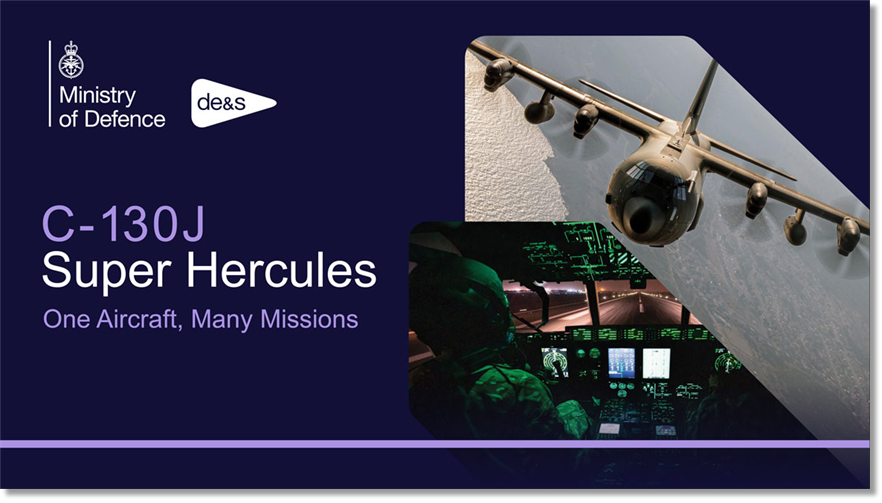
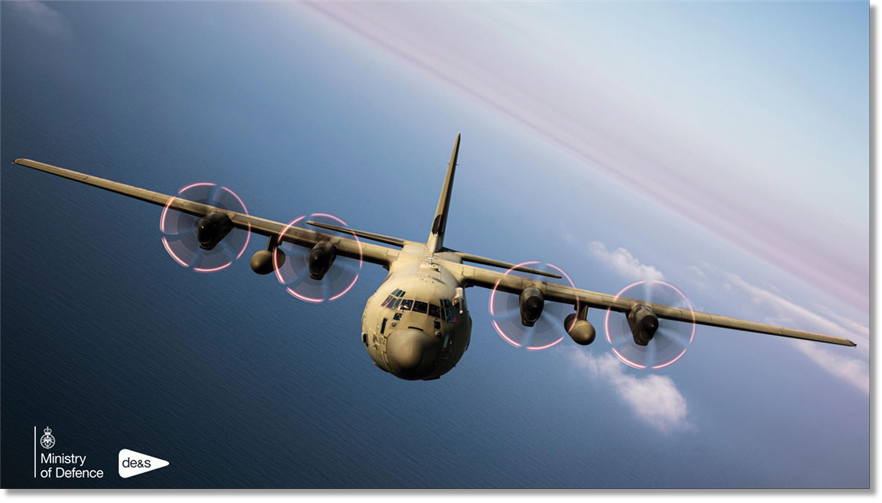
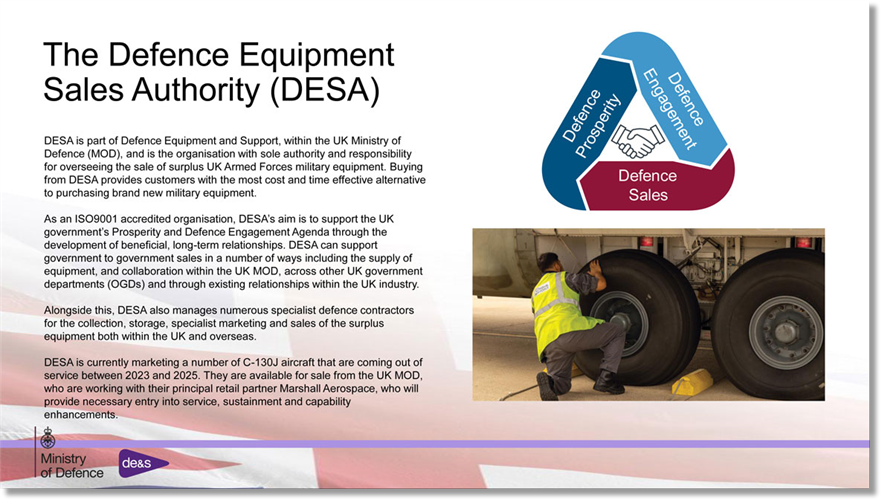
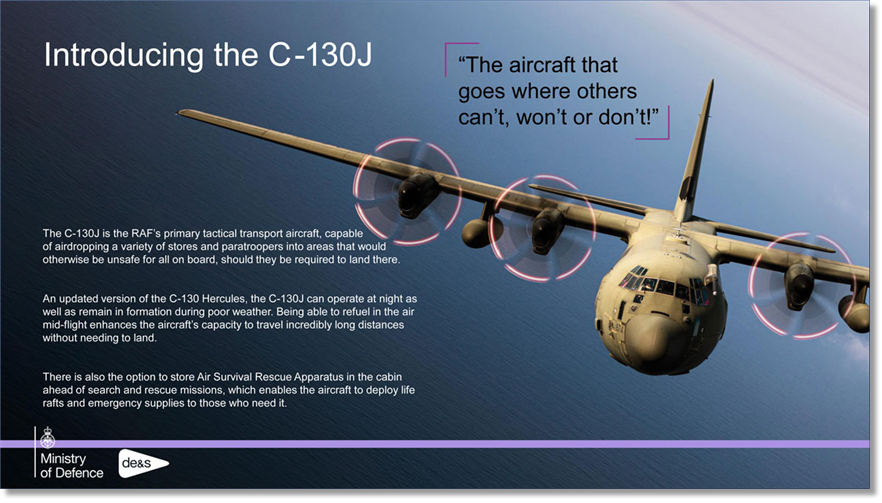
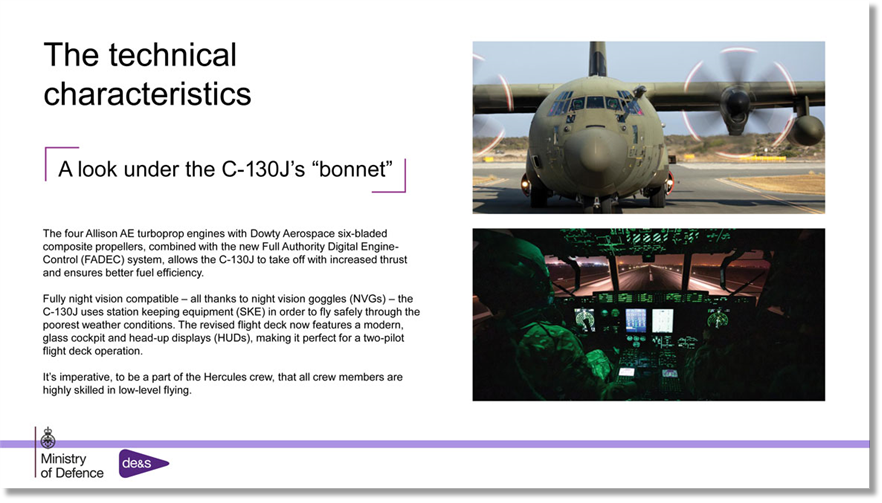
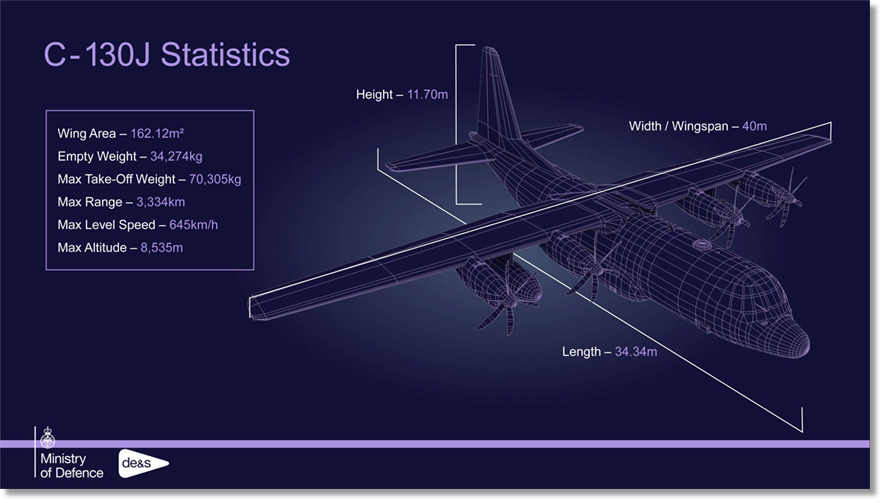
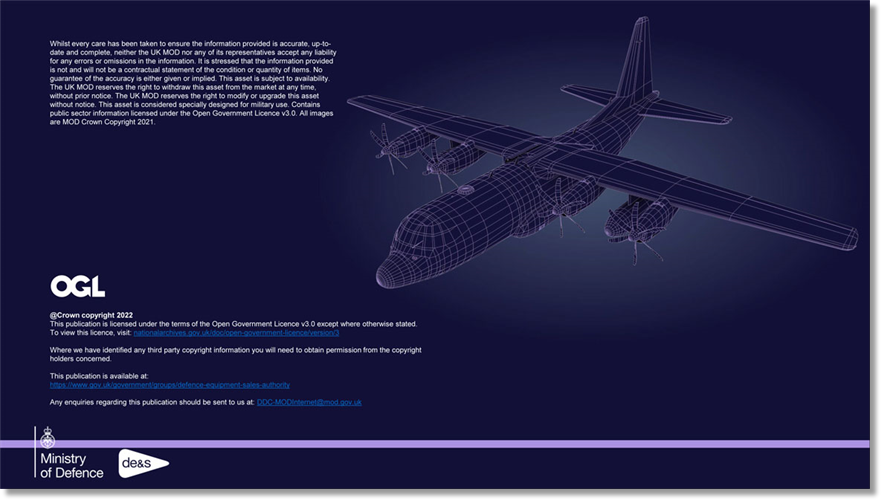
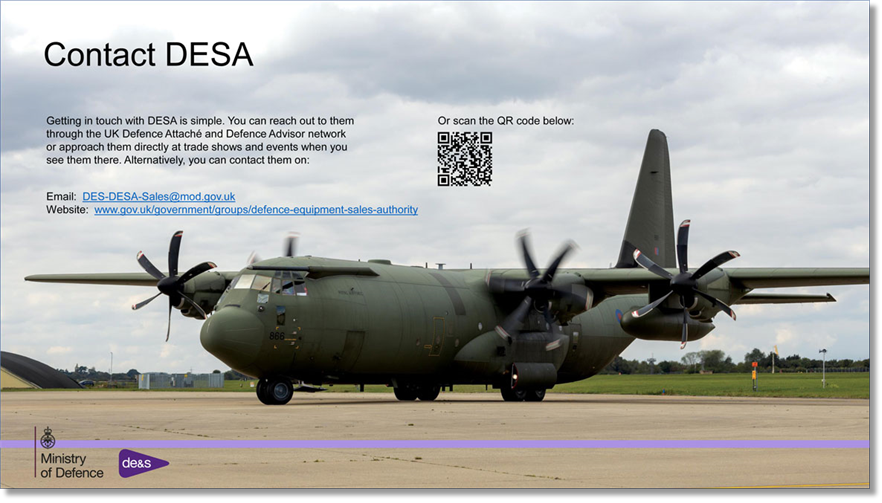

From: Syd Avery, Guardamar del Segura, Alicante
Subject: A rant about the sale of the C-130's
Hey Tony,
Whomsoever puts forward and makes these decisions [the sale of the C130's] are out of their tiny minds! Years ago, they decided to close Lyneham and move the Alberts to Brize Norton. Why? Cost was one reason. They gave the airfield to the Army. How does that reduce defence costs? So, all the transport and tanker fleets are in one target.
Additionally, Brize Norton is a one runway airfield. As shown this past year, the airfield was inoperative when the runway melted in places! Guess where number one bucket of canned sunshine will go? No doubt the numpties who made the decisions have been promoted to star rank in recognition of putting the country's security at risk.
Albert is supposed to be replaced by the Airbus A400. The Grizzly cannot do what the Albert can, and quite a few are unserviceable all the time. Not only R.A.F. ones, but those "in service" with other N.A.T.O. air arms. No doubt a political decision to buy the aeroplane, to keep Airbus Military afloat. And we all know how disastrous they are, both the decision and the aeroplane. The guys who fly them keep to the official line in public, but in private... ?
Rant over.
El Syd
Subject: A rant about the sale of the C-130's
Hey Tony,
Whomsoever puts forward and makes these decisions [the sale of the C130's] are out of their tiny minds! Years ago, they decided to close Lyneham and move the Alberts to Brize Norton. Why? Cost was one reason. They gave the airfield to the Army. How does that reduce defence costs? So, all the transport and tanker fleets are in one target.
Additionally, Brize Norton is a one runway airfield. As shown this past year, the airfield was inoperative when the runway melted in places! Guess where number one bucket of canned sunshine will go? No doubt the numpties who made the decisions have been promoted to star rank in recognition of putting the country's security at risk.
Albert is supposed to be replaced by the Airbus A400. The Grizzly cannot do what the Albert can, and quite a few are unserviceable all the time. Not only R.A.F. ones, but those "in service" with other N.A.T.O. air arms. No doubt a political decision to buy the aeroplane, to keep Airbus Military afloat. And we all know how disastrous they are, both the decision and the aeroplane. The guys who fly them keep to the official line in public, but in private... ?
Rant over.
El Syd


RNZAF B757 lands on the ice in Antarctica
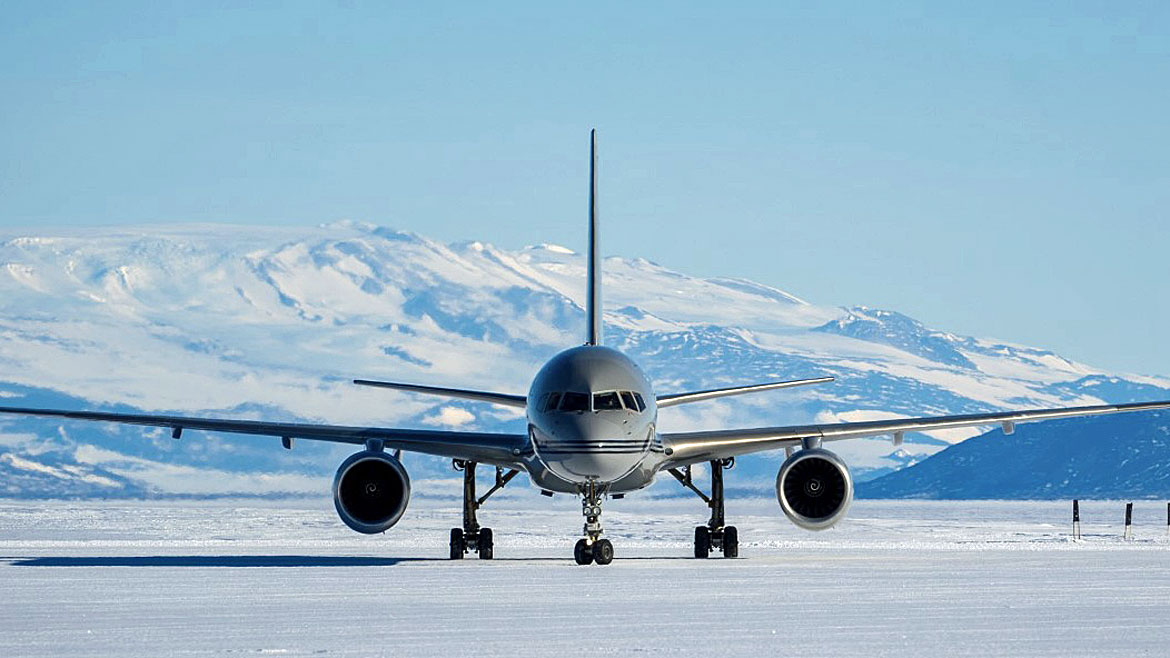
The coolest mission on earth - our Royal New Zealand Air Force Boeing aircraft and crew from No. 40 Squadron has begun flying passengers and cargo to Antarctica for the 2022/23 season.
Each year, under Operation Antarctica, we provide support to Antarctica science and research programmes. This includes air transport, personnel working with the New Zealand Antarctic Programme, and personnel for the New Zealand/United States Joint Logistics Pool. Over the 2022/23 summer season, we’ll deploy about 200 personnel in a variety of roles to support New Zealand and United States Antarctic programmes.
Our Hercules aircraft will also be flying missions to the ice, and over the course of the season, we will have 27 personnel based at Harewood Terminal assisting with air movements on Antarctic flights.
With thanks to Kit Ayers
Each year, under Operation Antarctica, we provide support to Antarctica science and research programmes. This includes air transport, personnel working with the New Zealand Antarctic Programme, and personnel for the New Zealand/United States Joint Logistics Pool. Over the 2022/23 summer season, we’ll deploy about 200 personnel in a variety of roles to support New Zealand and United States Antarctic programmes.
Our Hercules aircraft will also be flying missions to the ice, and over the course of the season, we will have 27 personnel based at Harewood Terminal assisting with air movements on Antarctic flights.
With thanks to Kit Ayers
Tony Gale
ukmamsoba@gmail.com
ukmamsoba@gmail.com
This Newsletter is Dedicated
to the Memories of:
Mike Bush (RAF)
Dave Sadler (RCAF)
to the Memories of:
Mike Bush (RAF)
Dave Sadler (RCAF)







